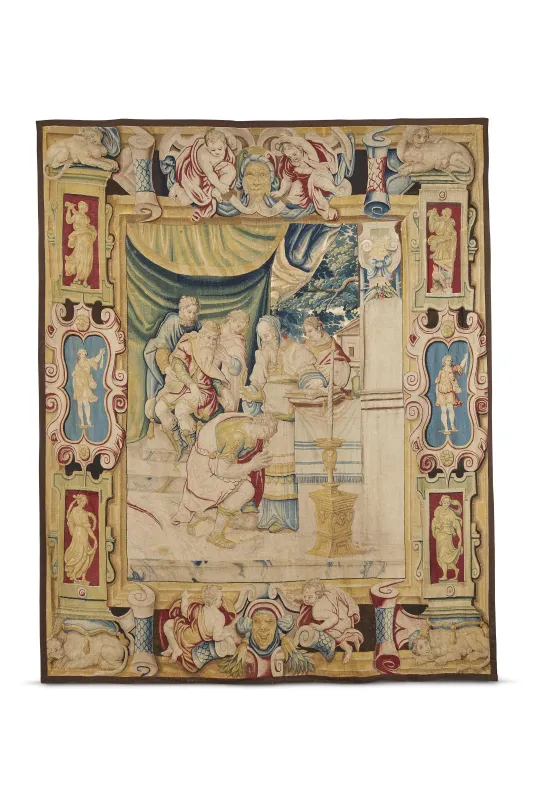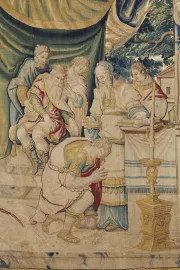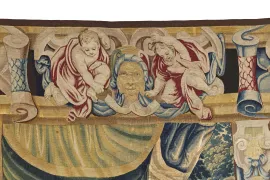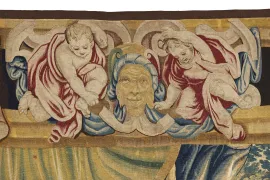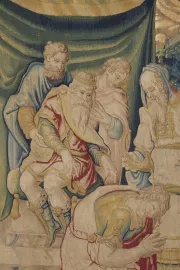Benedetto Di Michele Squilli
(active from 1555 to 1588)
to cartoon by Stradanus
(Jan van der Straet, Bruges 1523 – Florence 1605)
THE ANOINTING OF KING DAVID, 1568
Comparative literature
E. Spinelli Barelli, L’arazzo in Europa. Novara 1963;
M. Viale Ferrero, Arazzi italiani. Venice 1969;
G. Gaeta Bertelà, in Firenze e la Toscana de’ Medici nell’Europa del cinquecento. Palazzo Vecchio: committenza e collezionismo medicei, catalogue of the exhibition. Florence 1980;
L. Meoni, Gli arazzi nei musei fiorentini. La collezione medicea: La manifattura da Cosimo I a Cosimo II (1545-1621). Livorno 1998
Techniques and Materials:
Warp: undyed spun wool, S-twist, three ply, 5 ends/cm.
Wefts: in coloured wool and silk. Wool: Z-twist, three-ply, 7-9 picks/cm. Silk: without appreciable twist, 9 picks/cm.
Overall dimensions: 333 x 410 cm
Upper horizontal border: 71 cm height
Lower horizontal border: 69 cm height
Vertical border: 65 cm width
The borders are trimmed and the horizontal and vertical selvedges are missing.
Backing: the tapestry is backed in strips, five vertical and two horizontal (one at the top and one at the bottom). The horizontal strips are brown linen canvas but do not appear to be original as instead do the vertical strips of hemp canvas. Disassembly of the backing strips from the work revealed numerous letter and number markings. From right to left: the first strip on the right is marked with the lettres couchées C and T, both painted in black; the second, with a sepia-painted number, perhaps 65; the third bears no markings; the fourth bears what appears to be the combination N309 in black and other letters and numbers in sepia ink which are extremely difficult to decipher, perhaps a capital S and a capital B (Squilli Benedetto?) with a double F (?) and N576 below; the fifth bears no markings.
The first series of the Stories of David tapestries date to 1561-1562: nine works woven to cartoons by Stradanus at the workshops of Benedetto Squilli and Giovanni di Bastiano Sconditi. This series includes the tapestry entitled Samuel Anoints David as King, the entry for which was written by Giovanna Gaeta Bertelà (G. Gaeta Bertelà, in Firenze e la Toscana de’ Medici nell’Europa del Cinquecento. Palazzo Vecchio: committenza e collezionismo medicei, catalogue of the exhibition. Florence, 1980, pp. 70-71, no. 115).
In both this and our tapestry, the subject is the same; the reference cartoon would also seem to be the same despite the fact that in our tapestry the woven scene is taller and narrower than in the other.
There are several analogies between the two. The six figures in our tapestry are the same appearing in the comparison piece, although with slight colour variations; the layout of the scene and the arrangement of the figures is the same in both works; the curtain, the architectural elements, the floor and the candelabrum are also very similar in both.
Certain differences are of note. In our tapestry, which is smaller than the other, the two standing figures on the left side are excluded; the background of our tapestry includes trees, besides a building which appears in both works.
The borders are not identical: although there are analogies in the poses of the cupids, our tapestry border includes sphinxes which do not appear in the other.
Two further series with Stories of David appear later, in 1567-1568, listed in the Guardaroba Medicea in filze (files) 47 and 48. The first comprises scenes depicting David’s preparations to combat the giant Goliath (1567-1568); the other, relative to the ‘second phase’ of the exploit, scenes of the slaying of Goliath and David’s triumph (1568). The latter, once believed to have been irremediably lost (in this connection, see the following documents in the Archivio di Stato of Florence. 13 January 1568 [Florentine calendar 1567 ab incarnatione], Guardaroba Medicea 47, fols. 131d, 134d, 136d, [fol. 134d]; Guardaroba Medicea 48, fol. 136v. Conti, 1875, 53. 18 June 1568 Guardaroba Medicea 47, fols. 139s and d, 148s and d, [fol. 148s]; Guardaroba Medicea 48, fols. 136v, 139r. 18 June 1568, Guardaroba Medicea 47, fols. 148d, 150d; Guardaroba Medicea 48, fol. 139r. 12 October 1568, Guardaroba Medicea 47, fols. 148d, 150d; Guardaroba Medicea 48, fols. 140v to 141r), dates to the period in which management of the tapestry-weaving workshop, Sconditi having completely disappeared from view, fell entirely to Benedetto di Michele Squilli. This is the series, we might conjecture, to which our tapestry belongs.
One element likening our tapestry to the tapestry identified by Giovanna Gaeta Bertelà as David Asks to Fight Goliath (Pisa, Museo Nazionale di San Matteo, inv. 1513) from the above-cited first series of the later works depicting Stories of David are the appearance in the borders of small, slender male figures, shown standing on pedestals, carrying shoulder bags and cloths or slings (?) in their hands, portrayed within scrolled cartouches.
Analysis of the style of the scene depicted in our tapestry and the broad treatment of the characters points up notable analogies with the Stories of Cosimo the Elder, a later series of tapestries woven by Florentine weavers under the supervision of Benedetto di Michele Squilli to cartoons by Stradanus, coordinated by Giorgio Vasari and with the consultancy of scholars Cosimo Batoli and Vincenzo Borghini. The borders also show correspondences at various points. The sphinxes, which in our tapestry have abbreviated headpieces, are not present in Samuel Anoints David as King, from 1561, but instead appear in such tapestries in the Stories of Cosimo the Elder series as Cosimo the Elder Builds the Badia Fiesolana (1570-71) (in this connection and as regards the subjects listed below, see L. Meoni. Gli arazzi nei musei fiorentini. La collezione medicea. La manifattura da Cosimo I a Cosimo II (1545-1621), Livorno, 1998, pp. 238-239; pp. 240-241, no. 64; p. 242, no. 65; p. 243, no. 66), Cosimo the Elder Builds a Library for San Giorgio Maggiore in Venice (1570-1571), Cosimo the Elder Subsidises Francesco Sforza (1570-71), Cosimo the Elder Builds a Pilgrim Hospice in Jerusalem (1570-1571); other analogies with the borders of the above-cited tapestries are the statues in the rectangular niches, treated in exactly the same manner and using the same colours, and the central scrolled cartouches, which in our tapestry are each occupied by a small male figure and in these works by portraits in medallions; one difference resides in the lack, in the fruit and flower compositions, of the ribbon which is instead present in all the others.
In about 1556, Jan van der Straet, known as Stradanus, appeared as a cartoonist at the Arazzeria Medicea. The artist hailed from Bruges, where he received his early instruction in the arts from his father; he then studied in Antwerp with Maximiliaen Francken and Pieter Aertsen; lastly, he came to Italy, to Venice and thence to Florence. Borghini’s observation that ‘from the start of his stay in Florence he collaborated to produce cartoons for the Arazzeria’ is probably true, even though his name does not appear in the accounts before 1557 (by which date he had already been in Florence for nine years).
It is in fact possible that the ‘grotesques’ he produced were, as Borghini suggests for headboard tapestries: he could have collaborated on the transposition of Bachiacca’s designs into large cartoons, since he was a skilled decorator and portrayer of animals. After entering Giorgio Vasari’s orbit, Stradanus’ first ascertained major work at the Arazzeria involved the decoration and refurbishment of Palazzo Vecchio entrusted by Cosimo I to Vasari, who acted as general director and supervisor. The declared aims of the project for the fresco decoration of Palazzo Vecchio were to glorify the Medici house and, not incidentally, to lay an aesthetic, historic and moral framework justifying Cosimo’s absolutism.
Just as transparent, the meanings of the tapestries prepared for the prince’s rooms, depicting the Stories of Cyrus, Jesse and Solomon; among the characters we find only one of the ancient heroes. These last tapestries were not in direct relation to the frescoes.
As production of the tapestries at the Arazzeria Medicea progressed through time, the level of technical excellence declined until by the time the Florentine Stories (1569) were woven for the apartments of Leo X (from 1556 to 1562), the workmanship no longer displayed that sophistication which had marked the Arazzeria’s earlier efforts. Only naturally, it was also necessary to create the cartoons more quickly. Vasari’s involvement no longer went beyond delivery of the subjects or at the most a few suggestions concerning composition; the actual drawing was left to Stradanus, who, in the manner of the Flemish cartoonists, produced sketchy characterisations. The result in Stories of David is not unpleasant; differently, for example, to the Stories of Hercules (1565), in which a Michelangelo-like gigantism, inspired by Vasari, results in rather unfortunate effects.
Not many of the pieces mentioned in the documentary and other sources have come down to us. This is explained by the fact that this production was intended for everyday use at the Medici court and was thus subject to rapid deterioration. Among the surviving works, The Anointing of David is still in Palazzo Vecchio along with two other tapestries: one a scene from the series on Roman history (Emperor Trajan and the Widow), the other The Victory of Hercules over the Centaur, on display in the Sala di Ercole, the only piece which has remained in its original location. This being the case, it might be said that the decorative project so studiously planned by Vasari has been totally lost to us.
Lucia Nucci

